Clash of Titans
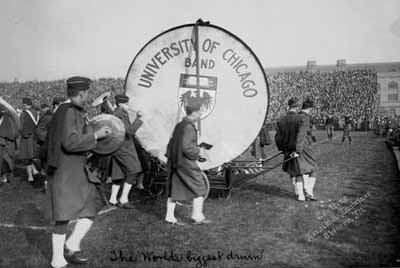
Before kickoff, the Chicago band took the field with "The World's Biggest Drum," "Big Bertha.
Archival Photographic Files, [apf4-01704], Special Collections Research Center, Univ. of Chicago Library.
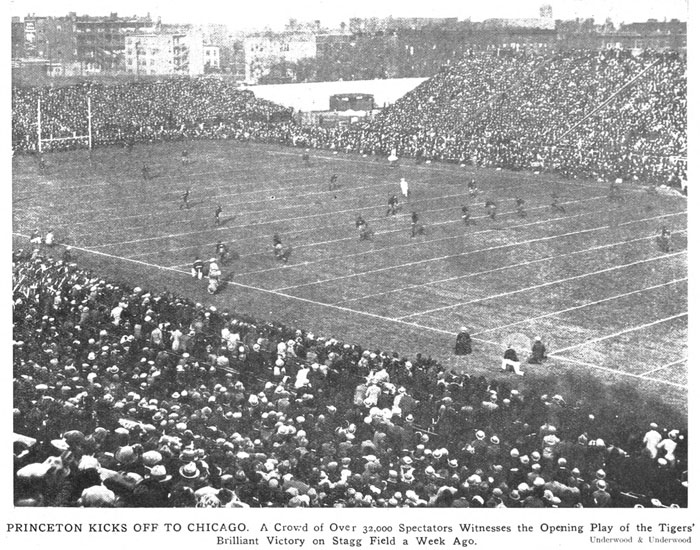
Princeton kicks off to Chicago before 32,000 at Stagg Field. The Daily Princetonian, 11/4/1922

Princeton-Chicago action
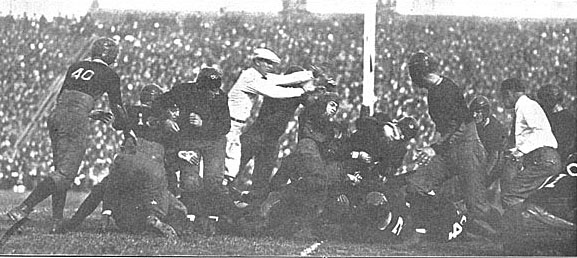
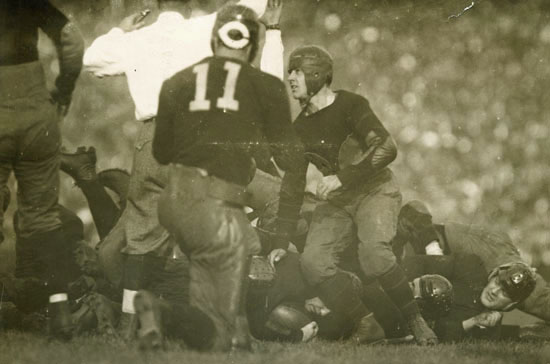
Two views of Princeton's first touchdown.
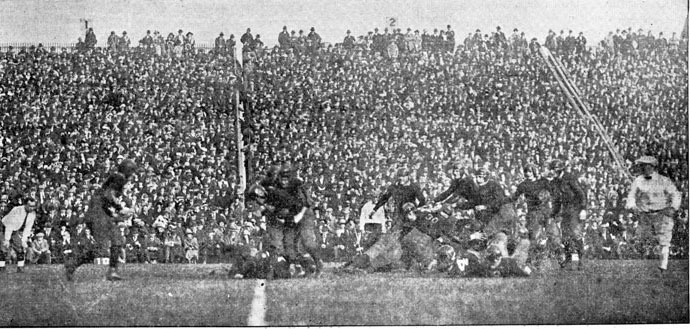
Thomas of Chicago with ball on Princeton 15 in second quarter as Emery tackles.
The Daily Princetonian 10/30/1922
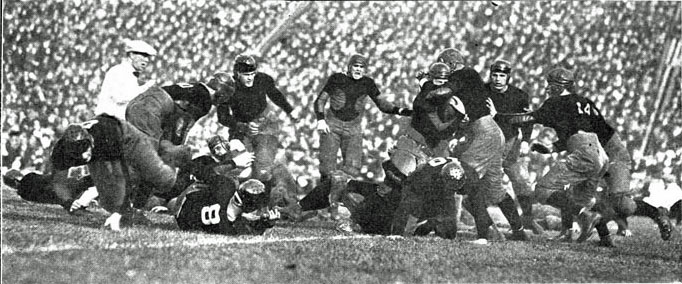
Pyott of Chicago thwarted by the Princeton tacklers. The Daily Princetonian, 11/4/1922
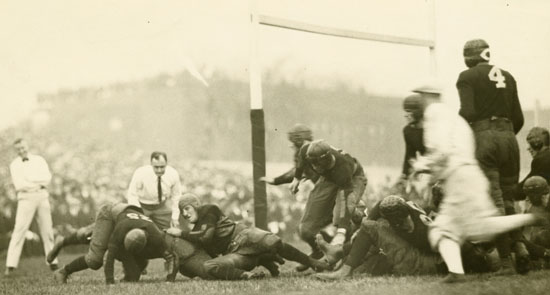
Archival Photographic Files, [apf4-00458], Special Collections Research Center,
University of Chicago Library.
October 28, 1922: Princeton @ Chicago
Amos Alonzo Stagg vs William Roper
First Half
First Half
"Uphold the Honor and Traditions of the East"
When two esteemed coaches pick the same game as the most dramatic of their long careers, that contest merits attention.
 |
In 1922, Amos Alonzo Stagg, "the most revered man in the sport," was in the 31st year of what would be a 40-year tenure at the University of Chicago, a Western Conference (Big Ten) member. Stagg was known as a master strategist. He was one of the first coaches to use the forward pass on the end of a double reverse; he pioneered double and triple passes behind the line, split buck, end-around runs, laterals, and line-shifts. Knute Rockne used to say, "All football comes from Stagg." His numerous innovations included: the huddle (1896); direct pass from center ('96); wind sprints ('96); man in motion ('99); unbalanced offensive line (1900); backfield shift ('04); numbering players ('13); and cross-blocking ('18). |
|
The Princeton Tigers, making their first gridiron foray into the Midwest, were coached by alumnus William Roper, whose second term as head man at the school began in 1919 after he had served as a lawyer, insurance man, and Philadelphia city councilman. In contrast to Stagg, Roper didn't specialize in tactics and techniques. He had no playbook. Instead, he "had a flare for grand strategy and could impart this to quarterbacks." He let his players think for themselves. Occasionally, he would dictate a play if an opponent had used it successfully against Princeton.
Roper was one of the last of the great romantic football coaches. Where other mentors were remembered for tricky systems and won-lost records, Bill Roper will be forever associated with locker-room oratory, come-from-behind victories, and heart-stopping upsets. One of his 1922 stars recalled: "Coach Roper was a true Princetonian from the old school. He convinced us that if we wore Orange and Black colors and the other side didn't, we had them licked." |
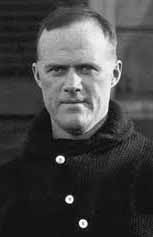 William Roper |
The hype for the game reached epic proportions. Princeton brought a 4-0 record to the Windy City. The Maroons were undefeated in three games. The Tigers sought revenge for the 9-0 beating Stagg's boys had administered in Princeton the previous season. However, Chicago was considered a 3-to-1 favorite over a Princeton team that even for that era was considered small.
Stagg Field's 32,000 seats, including temporary bleachers in the end zone, had been sold out for weeks. If Chicago had offered standing room tickets, the crowd could have been much larger.
Entire Nation Tunes In
It was the first football game heard coast to coast. The broadcast was carried on phone lines to New York City, where the nationwide transmission originated. People with receivers could listen in their own homes to one of the 200 radio stations across the nation. Countless others gathered around radios in Western Union offices and speakeasies. Back at Princeton, students crowded into the physics lab. It seemed as if everyone in the New Jersey town was within earshot of a radio tuned to station WOR in Newark.
The schools were not only highly esteemed academic institutions but had also carved out a reputation as football powers. Each squad represented the aspirations of its section of the country. With Yale and Harvard, Princeton constituted the Big Three that had dominated football for 40 years. The Tigers had disappointed the Eastern Establishment by losing to the upstarts from the Windy City the year before. Roper urged his minions to uphold the honor and tradition of the East.
Chicago carried the aspirations of the heartland against the Elite East. Midwest football had received a boost in 1913 from an unexpected quarter when tiny Notre Dame had vanquished mighty Army 35-13 thanks to the passing combination of Gus Dorais and Knute Rockne. Chicago could give the section's esteem a booster shot with a victory over Princeton.

Before kickoff, the Chicago band took the field with "The World's Biggest Drum," "Big Bertha.
Archival Photographic Files, [apf4-01704], Special Collections Research Center, Univ. of Chicago Library.

Princeton kicks off to Chicago before 32,000 at Stagg Field. The Daily Princetonian, 11/4/1922
The first minutes of the contest illustrated the contrasting tactics of the two coaches. Princeton won the toss and elected to defend the north goal. The kickoff sailed into the end zone; so the Maroons began play at the 20. However, on the first play, O. E. Strohmeier punted to midfield. After accepting a 5y penalty on Princeton for offsides, Chicago punted again! Princeton lined up in punt formation but ran instead only to lose 3y. Illustrating what one of his players said about Roper's offense, "There was no rhyme or reason about [the plays], and none was keyed to any other play," next came a long pass, but Maroon captain Jimmy Pyott intercepted on his 15.
Given momentum by the turnover, what did Chicago do? They punted! From its 45 after an offsides penalty, Princeton tried a double pass, but E "Whoops" Snively was tackled for a 12y loss. Princeton punted across field to Pyott who was dropped at his 40.

Princeton-Chicago action
Chicago Scores First
With favorable field position, Stagg unleashed his offense, which used a shift that seemed to baffle Princeton. Star back Johnny Thomas, a 22-year-old World War I veteran from Jamestown ND, carried seven times in 10 plays for 37y as the Maroon mass drove through the smaller Tiger linemen to the end zone for a 6-0 lead. A new rule for 1922 called for the ball to be placed at the five for the PAT, which could be scored by running or passing rather than the traditional placekick. The missed kick failed to dampen the enthusiasm of the confident Chicago crowd. The points were the first surrendered by Princeton all season.
Under the rules of the day, the team that was scored upon had the choice of kicking off or receiving the kick. Princeton chose to kick. As if sportingly saying, "We give you a chance now," Chicago punted on second down. But the strategy backfired as Jack Cleaves returned the ball from his 45 behind excellent interference to the Maroon 23. After two ground plays gained three, a third down pass fell incomplete. T "Pink" Baker then tried a drop kick field goal from the 32 but missed.
On the first play after taking possession, Pyott punted to QB Johnny Gorman (5'7" 154), who made a fair catch on the Princeton 45.
Tigers Take Lead
The visitors from the east drove for their first touchdown. On third-and-four, Harry Crum, on a fake double pass, gained just enough for the first down. On the next play, Crum fumbled but recovered. Catching the Maroon secondary asleep, Snively shot a pass to E Howard "Howdy" Gray all the way to the seven. A penalty moved the ball to the five. Crum plunged up the middle for a yard as the period ended.
Crum pushed forward for two, then a half yard. On fourth down, Cleaves squirmed over for the tying touchdown. Ken Smith kicked the goal that put the Tigers on top 7-6. The Princetonians had made a statement that they didn't come west to be a sacrificial lamb. Game on!


Two views of Princeton's first touchdown.
The Maroons fought back as any outstanding team would. The team that was scored on got to pick whether to kick or receive, and Chicago chose to kick off. The move paid off because the Tigers tried to punt back on first down, but the kick was blocked and went out of bounds on Princeton's 31. The Maroons capitalized on the break to retake the lead. Running behind the blocking of Joe Pondelik and Lloyd Rohrke, Thomas smashed through the line twice for 8y, then sprinted around left end on a double pass for a first down on the 17. Harry Thomas, John's brother, gained five, then Johnny for two and four. On a fake end run, John Thomas roared into the end zone. A bad pass from center voided the extra point try. Chicago 12, Princeton 7.
At this point, W. L. Zorn replaced John Thomas. That meant that Thomas could not return until the second half. If he were replaced then, he was through for the afternoon.

Thomas of Chicago with ball on Princeton 15 in second quarter as Emery tackles.
The Daily Princetonian 10/30/1922

Pyott of Chicago thwarted by the Princeton tacklers. The Daily Princetonian, 11/4/1922

Archival Photographic Files, [apf4-00458], Special Collections Research Center,
University of Chicago Library.
With its defenders worn down, Princeton tried an onside kick. Cleaves recovered "Pink" Baker's kick at the Chicago 35. After two runs gained four, Cleaves fired a pass to Smith to the 11. The Maroons stiffened, throwing first Gorman, then Van Gerbig for losses. Cleaves faked a drop-kick, then ran, but he too lost yardage. Smith tried a drop-kick for three points from the 25, but Fletcher blocked it. With a chance to eat up some time before halftime, Strohmeier instead punted to Cleaves, who signaled for a fair catch of the 45.
The Black and Orange again pushed deep into Maroon territory. Bob Beattie gained six, then three on a feint of a double pass. Then he rammed through center for a first down on the 31. On third-and-seven, Beattie connected with the speedy Cleaves who ran to the 21. However, Beattie fumbled on the next play, and Franklin Gowdy recovered for Chicago. The half ended a few plays later. Chicago 12, Princeton 7